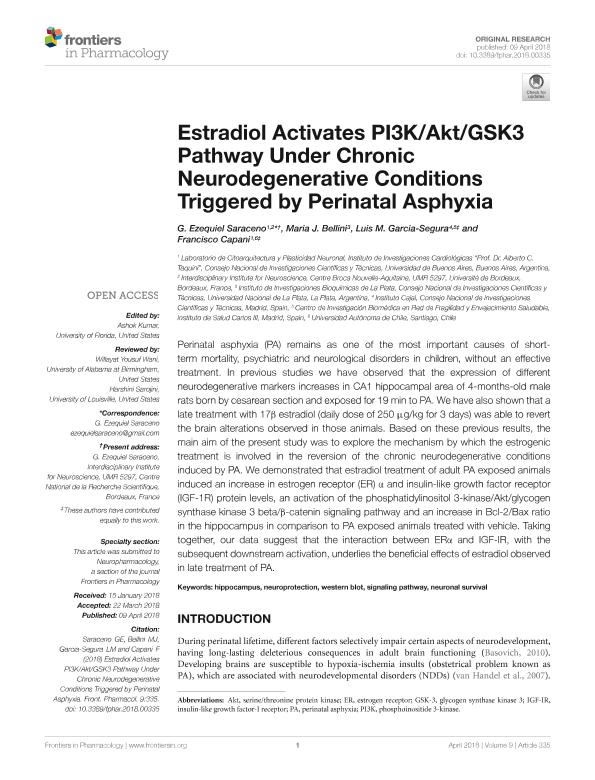Artículo
Estradiol activates PI3K/Akt/GSK3 pathway under chronic neurodegenerative conditions triggered by perinatal asphyxia
Fecha de publicación:
04/2018
Editorial:
Frontiers Media S.A.
Revista:
Frontiers in Pharmacology
ISSN:
1663-9812
Idioma:
Inglés
Tipo de recurso:
Artículo publicado
Clasificación temática:
Resumen
Perinatal asphyxia (PA) remains as one of the most important causes of short-term mortality, psychiatric and neurological disorders in children, without an effective treatment. In previous studies we have observed that the expression of different neurodegenerative markers increases in CA1 hippocampal area of 4-months-old male rats born by cesarean section and exposed for 19 min to PA. We have also shown that a late treatment with 17β estradiol (daily dose of 250 μg/kg for 3 days) was able to revert the brain alterations observed in those animals. Based on these previous results, the main aim of the present study was to explore the mechanism by which the estrogenic treatment is involved in the reversion of the chronic neurodegenerative conditions induced by PA. We demonstrated that estradiol treatment of adult PA exposed animals induced an increase in estrogen receptor (ER) a and insulin-like growth factor receptor (IGF-1R) protein levels, an activation of the phosphatidylinositol 3-kinase/Akt/glycogen synthase kinase 3 beta/β-catenin signaling pathway and an increase in Bcl-2/Bax ratio in the hippocampus in comparison to PA exposed animals treated with vehicle. Taking together, our data suggest that the interaction between ERa and IGF-IR, with the subsequent downstream activation, underlies the beneficial effects of estradiol observed in late treatment of PA.
Palabras clave:
HIPPOCAMPUS
,
NEURONAL SURVIVAL
,
NEUROPROTECTION
,
SIGNALING PATHWAY
,
WESTERN BLOT
Archivos asociados
Licencia
Identificadores
Colecciones
Articulos(INIBIOLP)
Articulos de INST.DE INVEST.BIOQUIMICAS DE LA PLATA
Articulos de INST.DE INVEST.BIOQUIMICAS DE LA PLATA
Articulos(ININCA)
Articulos de INST.DE INVEST.CARDIOLOGICAS (I)
Articulos de INST.DE INVEST.CARDIOLOGICAS (I)
Citación
Saraceno, Gustavo Ezequiel; Bellini, Maria Jose; Garcia Segura, Luis Miguel; Capani, Francisco; Estradiol activates PI3K/Akt/GSK3 pathway under chronic neurodegenerative conditions triggered by perinatal asphyxia; Frontiers Media S.A.; Frontiers in Pharmacology; 9; APR; 4-2018; 1-10
Compartir
Altmétricas




